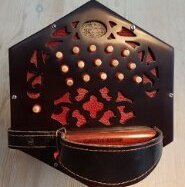-
Posts
1,744 -
Joined
-
Last visited
About alex_holden
- Birthday 02/06/1980
Contact Methods
-
Website URL
http://www.holdenconcertinas.com/
Profile Information
-
Gender
Male
-
Interests
Wood carving, metalwork, Morris Minors, folk music.
-
Location
Lancashire, England
alex_holden's Achievements

Heavyweight Boxer (5/6)
-
alex_holden started following Unique find , Peculiar posts inside Lachenal action , This is what I’m up against….. and 6 others
-

Peculiar posts inside Lachenal action
alex_holden replied to Alex West's topic in Instrument Construction & Repair
It does look like there used to be a sheet of leather or something glued to the tops of the outer ones. Seems like it would make action maintenance more difficult compared to the usual method of gluing the leather to dots of cork on the underside of the fretwork. -

This is what I’m up against…..
alex_holden replied to Lappy's topic in Instrument Construction & Repair
Card. Something like they make greeting cards or cereal boxes from should work, depending on how much thickness you need. -

Milwaukee Craftsman Concertina
alex_holden replied to srhill's topic in General Concertina Discussion
The branding seems like an insult to genuine Milwaukeean craftspeople. -

Reattaching veneer on a 1974 Crabb
alex_holden replied to Joe G.'s topic in Instrument Construction & Repair
Are you sure it's actually wood? Some of them from that period had black plastic veneer. If it is real wood, then hide glue is probably the best option because it is repairable if it ever comes off again in the future. If it is plastic, maybe some sort of contact adhesive? -
I'm not sure if this is how it's meant to be used, but if you hold one of the bowing levers while playing, one bellows direction sounds quieter than the other due to the air leaking through the small air hole. So playing a phrase with frequent direction changes will produce an alternating pattern of loud and soft notes. The trouble is you will quickly find yourself running out of air due to it leaking in only one direction, so at that point you have to swap to the other lever to make it leak in the opposite direction. IMHO it isn't very effective and is more of a sales gimmick than a useful feature.
-
Seems a bit like taking the engine out of your car to check the oil because the dipstick is in an awkward location. 😉
-
It could certainly be the surface finish of the leather. The leather I use for pad facing (CPL from Columbia Organ Leather) doesn't have a glossy surface. When I'm making bellows I lightly sand the areas where I'm going to glue leather to leather: the glue doesn't stick very well if you don't. You can also buy a special solvent called "deglazer" that is supposed to take the gloss off so that dye will soak in evenly. Hard to say if the PVA is too thick. You could try mixing in a few drops of water if it's difficult to brush on or dries very quickly.
-
In that case, if by "hollow" @bellowbelle means that the buttons can travel all the way down to the end plate surface (and potentially below it) without coming to a hard stop, perhaps she might consider adding external plates that raise the surface of the button surround, as demonstrated by @fred v : That's not possible with most action designs, unless you hit the button so hard you break it.
-
I seem to recall the Stagi action doesn't have any dampers under the buttons to limit their travel. The buttons are quite short and it's possible to keep pushing until they dip below the surface of the end plate. Is that right? It's been a few years since I worked on one. I found this picture elsewhere on the forum of a Stagi Hayden action: I think the buttons are also relatively large diameter compared to most traditional English-built concertinas.
-
Thicker chamois is preferable, but it can be difficult to find and consistency is more important. I once bought a skin that seemed unusually thick at first feel, but it delaminated into two very thin layers when I cut it. I use fish glue to attach it to the wood.
-
I've never found that to be necessary. Is the chamois you bought particularly oily?
-
Nice design! Will you add corner blocks inside to support the instrument?
-
It would probably roll overboard.










